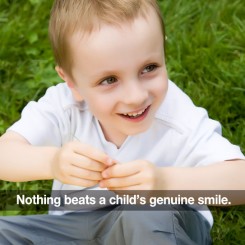
THERE’S A BIG DIFFERENCE between a real smile and a fake smile. And while a polite smile can help smooth over some social situations, a sincere, honest, from-the-heart smile (especially from your child!) can completely turn the day around. Have some fun with your kids discussing the difference between real and fake smiles.
What Is “The Duchenne Smile?”
The Duchenne Smile was named after 17th century French researcher Duchenne de Bologne. He believed that the key to a real smile (a genuine expression of happiness) was found in the eyes, and although the muscles around your mouth are easy to shape into a smile, the muscles around your eyes (the Orbicularis Orbiti) are only triggered by true happiness.
Can You Spot Fake Smiles? Take This Quiz!
This is really a lot of fun! Take the quiz yourself!
Do You Know How To Smize?
Smize means “smile with your eyes”. Despite Duchenne’s long-standing theory, recent research (and Tyra Banks) suggests that anyone can fake a “genuine” smile. What do you think?
One Key To Spotting A Genuine Smile Is Imitation
Smiles are literally contagious. When we see a smile we have a subconscious urge to reflect it back. And when we imitate a smile, we can FEEL whether or not it’s real. In a 2013 study subjects held a pencil in their mouth while scrolling through photos of people smiling. The pencil kept participants from reflecting the expressions they saw, handicapping their ability to read the emotions behind those smiles. Interesting!
Help Your Child Keep A Healthy And Confident Smile
Smiles are powerful. Genuine smiles are even more powerful. When you’re confident about your smile, it can truly change your life. So help your child set good habits NOW for a lifetime of healthy teeth, and always let us know what we can do to help!
